
Victorian Walnut Tunbridge Banded Lady's Work Box, Fitted Interior
A Victorian walnut and Tunbridge banded lady's work box with fitted interior, width 29 cm

Victorian Mahogany Tunbridge Ware Box, Late 19th Century, Striped Interior
A Victorian mahogany and Tunbridge Ware box, late 19th century, the rectangular box with rounded long edges to the lid, with patterned straps in coloured veneers and a lozenge shaped checkered cartouche, the interior relined in striped fabric. Height 13…

Victorian Walnut Tunbridge Ware Box with Mother-of-Pearl Detailing
A Victorian walnut and Tunbridge Ware box, late 19th century, the rectangular box with rounded corners in well figured walnut with patterned borders in coloured veneers and a lozenge shaped cartouche and escutcheon, with mother-of-pearl detailing, the…

Mid 19th Century Tunbridge Ware Writing Box - Tumbling Blocks
Antique Tunbridge ware writing box / slope mid 19th century, tumbling blocks pattern, closed 22 by 28 cm, height 7 cm, good condition

Victorian Tunbridge Ware Ink Bottle Box with Two Bottles
Victorian Tunbridge ware ink bottle bo x 10 cm x 6 cm x 6 cm, containing 2 ink bottles

Antique English Tunbridge Ware Deed Box, 19th Century
Tunbridge Ware antique English deed box, 19th century, 9 cm high, 30.5 cm wide, 20.5 cm deep
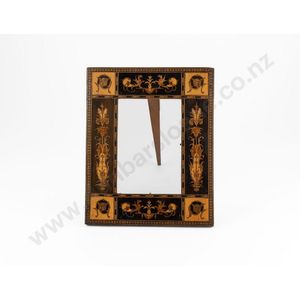
Victorian Tunbridge Ware Photo Frame - 24 x 19.5 cm
Victorian Tunbridge ware photo frame, 24 x 19.5 cm

Victorian Tunbridge Ware Glove Box: 27cm Long Antique
Victorian Tunbridge ware glove box, 27 cm long

Victorian Tunbridge Ware Container: Wood and Paper Slides (24cm)
Victorian Tunbridge ware container, with wood and paper slides, 24 cm long

Antique Victorian Tunbridge Ware Tea Caddy - 24cm Long
Victorian Tunbridge ware tea caddy, 24 cm long

Victorian Inlaid Cribbage Box with Tunbridge Ware Box
Victorian inlaid cribbage box, hinged to fold out as score board, containing four ivory pegs together with Tunbridge ware box, 13 cm & 10 cm long

Victorian Tunbridge Ware Boxes: 3 Unique Miniature Collectibles
Three Victorian Tunbridge ware boxes, 6.5 cm long, 5.5 & 3 cm diameter

Victorian Tunbridge Ware Box & Letter Opener Set
Victorian Tunbridge ware box & letter opener, 10 cm & 23 cm long
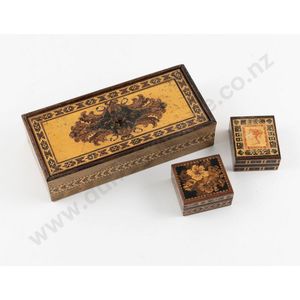
Set of Three Victorian Tunbridge Ware Boxes, 14cm & 4cm
Three Victorian Tunbridge ware boxes, 14 cm & 4 cm long

Victorian Tunbridge Ware Boxes: 3 Sizes, 9cm, 6.5cm, 4.3cm
Three Victorian Tunbridge ware boxes, 9 cm, 6.5 cm & 4.3 cm long

Victorian Floral Tunbridge Ware Box
Victorian Tunbridge ware box, of rectangular form with a domed hinged cover, decorated with floral motifs, 8 cm x 24 cm x 9.5 cm

Tunbridge Ware Lace Maker's Box
An exceptional Tunbridge ware lace maker's box with drop-front spindle and compartments, a fine and early example most likely from the workshop of James Burrows, circa 1820, 12 cm high, 29 cm wide, 12 cm deep. Provenance: The Jason E. Sprague collection,…

Victorian Tunbridge Ware Cube Inlaid Box
A Victorian Tunbridge ware box, rectangular with domed hinged lid inlaid with tumbling cube pattern in decoratively grained veneers. Blue velvet and satin lined. 24 x 10 x 8.5 cm.

Victorian Tunbridge Writing Slope with Mixed Timber Tiles
A Victorian Tunbridge ware burr elm writing slope, 19th century, in light honey tones with a fine and tight burr, with a compartment in a grained finish for pens and a fold down velvet covered slope, the surface decorated with twin bands of slanted tiles…
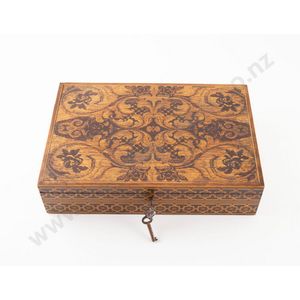
Floral Inlaid Victorian Tunbridge Ware Work Box
Victorian Tunbridge ware work box, all inlaid with floral lozenge design to lid and geometric design to edges 27 x 18 x 6.5 cm
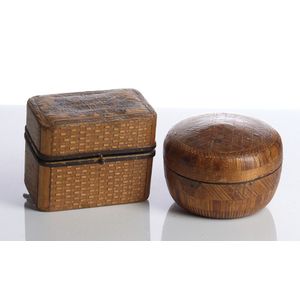
19th Century French Straw Work Boxes
Two French straw work boxes, 19th century, the first of circular form, decorated with geometric straw work panels, the other of rectangular form, the hinged lid inset with a floral Tunbridge ware panel, the rectangular box 9 cm high, 11 cm wide, 6.5 cm…

Victorian Burr Walnut Casket with Tunbridge Ware Inlay
A Victorian burr walnut casket with Tunbridge ware inlay, mid 19th century, the restored box having a fine aged patina, with blonde burr walnut to the lid and long sides, grain walnut to the short sides, with stringing, cross banding and patterned strap…

Marquetry Walnut Writing Slope with Leather Interior
A large Tunbridge style walnut boxed writing slope with leather inner slope and compartments. As well as intricate marquetry decoration. Length 50 cm, width 25.5 cm (box) Length 41.5 cm, width 44.5 cm (slope)
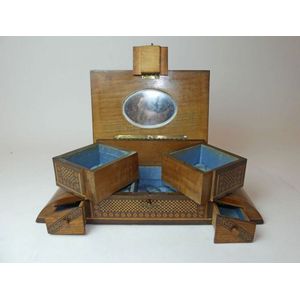
Art Deco Marquetry Jewellery Box with Music Box
A Tunbridge ware style Art Deco marquetry jewellery box lift up lid having an internal mirror, opening to four compartments with two drawers. With windup music box mechanism. Height 11.3 cm, width 34.5 cm

Tunbridge Ware Collectibles
Tunbridge ware various Collectable items inc, page Turners, stamp boxes, timer etc

Victorian Walnut Inlaid Tunbridge Ware Sarcophagus Box
A Victorian Tunbridge ware inlaid walnut box, walnut with parquetry banding, sarcophagus shape, inlay banding, with key, 14 x 21 x 15 cm

Tunbridge Ware Box with Classical Architecture and Floral Design
Late 19th century Tunbridge ware box, c.1880, of rectangular form, the cover decorated with classical architectural buildings, surrounded by a floral border repeated on the lower frieze, 10.5 x 24 x 19 cm

Victorian Tunbridge Ware Basket with Blue Fabric Sides
A Victorian Tunbridge ware basket, the wooden base and rim with geometric designs, the basket sides in a pleated blue fabric, fine wooden swing handle. Diameter 16 cm.

Victorian Tunbridge Ware Stationery Box with Castle Design
A Victorian Tunbridge ware stationery box, the exterior decorated with a castle to the lid and foliage to the sides, the interior with small compartments. 16 cm x 10 cm x 12 cm.

Victorian Tunbridge Ware Octagonal Box
Victorian Tunbridge ware octagonal lidded box decorated lid and sides, diameter 12.5 cm.

Inlaid Writing Slope with Fitted Interior
Victorian Tunbridge writing slope, of rectangular form, decorated with bands of inlaid geometric motifs, opening to fitted interior with writing slope and twin inkwells, 14 cm x 35 cm x 22 cm

Victorian Tunbridge Ware Inlaid Walnut Box
A Victorian Tunbridge ware box, the walnut exterior decorated with inlaid decoration, the interior relined and with a lift out tray. 30.5 cm x 22 cm x 14 cm.

Victorian Inlaid Writing Slope with Fitted Interior
Victorian Tunbridge writing slope, of rectangular form, decorated with bands of inlaid geometric motifs, opening to fitted interior, writing slope and twin inkwells, 14 cm x 35 cm x 22 cm

19th Century Miniature Boxes Collection
An English Tunbridge ware miniature box, pair of yew and bone circular snuff boxes and a yew and birch box, 19th century, the largest 16.5 cm across

Inlaid Castle Book Rack
Good Tunbridge ware adjustable book rack, inlaid castle decoration, (width 34 cm un-extended).
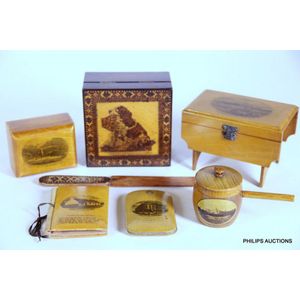
19th Century Mauchline and Tunbridgeware Collection
Five Mauchline wares and two Tunbridgeware items, 19th century, comprising a small box, a small hinged notebook, a silk lined pins and needles book, a pot with handle thimble holder (and thimble), a table type hinged box, a rosewood trinket box with…
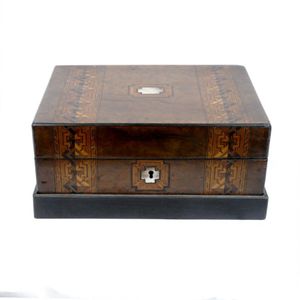
Victorian Tunbridge Ware Work Box with Contents
A Victorian Tunbridge ware work box, the exterior with traditional decoration, the interior with fitted compartments with various interesting contents. Provenance: The Flower Family Collection. 27 cm x 20 cm x 12.5 cm

Tunbridge Ware Inlaid Timber Box - Antique
Antique Tunbridge ware inlaid timber box, width 25 cm x depth 16 cm x height 14.5 cm
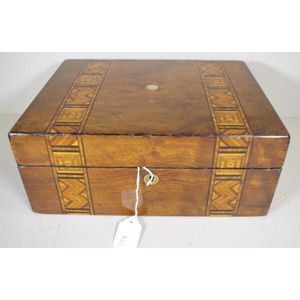
Tunbridge Inlaid Victorian Walnut Workbox, c1880
Victorian walnut workbox, with Tunbridge inlay and lift out tray, c1880.

Victorian Walnut Tunbridge Ware Box
A Victorian walnut Tunbridge ware box, 19th century, rectangular with twin straps to the lid and front with coloured chevron borders, with cross banding and stringing, with key; the interior with black fabric lining, height 10.5 cm, length 17.5 cm, width…

Tunbridge Ware Inlaid Box with Mother of Pearl Key
Tunbridge ware timber inlaid box, with mother of pearl escutcheon and key, 26 cm x 16.5 cm, 15 cm high

Tunbridge Ware Travel Box with Writing Slope and Jewellery Tray
Tunbridge ware ladies travel box, with jewellery tray, writing slope, ink well and key, 27.5 cm x 19.5 cm, 14.5 cm high

Tunbridge Ware Inlaid Box with Key
Tunbridge ware inlaid box, with key, 28.5 cm x 20.5 cm, 13.5 cm high
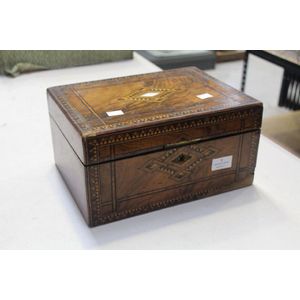
Antique Tunbridge Work Box with Mother of Pearl Cartouche
Antique Tunbridge work box with a mother of pearl cartouche, 15 cm high, 30 cm wide, 23 cm deep

Sorrento Ware Marquetry Mirror Frame
A fine Sorrento Ware marquetry frame with mirror, late 19th century, in mixed timbers, with Tunbridgeware style borders and grotesque motifs, demi-figures and fantastic beasts on an olive wood back. Height 26 cm, width 21.5 cm

Walnut Writing Box with Parquetry Bands and Fitted Interior
A walnut Tunbridgeware writing box, later 19th century, with key, the well figured box with parquetry bands, a feather banded and decorated rectangular cartouche and matching escutcheon, the fitted interior with a black tooled leather writing slope, pen…

Antique Writing Slope with Tunbridgeware Trims
A fine burr walnut writing slope with Tunbridgeware trims, 19th century, the flat topped arched lid with perspective cube key fret borders in coloured timbers, a bordered mother-of-pearl cartouche and matching escutcheon, opening to a baize lined writing…

Victorian Tunbridge Writing Slope and Rectangular Box
A Victorian Tunbridge ware writing slope and a rectangular box, the slope 30 x 25 cm, the box 27 cm wide

Tunbridge Ware Burr Timber Inlaid Box with Geometric Inlay
Tunbridge ware burr timber inlaid box with a silk lined interior lid & later work to the box interior. A burr veneer with two bands of geometric inlay, mother of pearl inlaid keyhole, with a key & certificate.
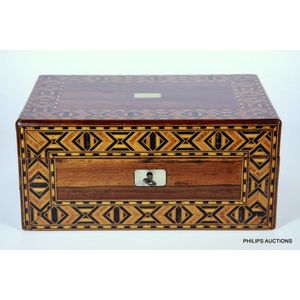
Rosewood Tunbridgeware Work Box with Parquetry Borders
A Tunbridgeware rosewood work box, later 19th century, the box with a fitted compartmentalised tray covered in red patterned paper, the box with bold patterned parquetry borders and mother-of-pearl escutcheons; with key, height 12 cm, width 25 cm, depth…

Antique Tunbridge Ware Casket
An antique mahogany Tunbridge ware casket, 19th to early 20th century, the small domed casket with a diamond motif in mixed timbers and decorative banding to the lid, the escutcheon similar, with key. Height 10.5 cm. Width 17.5 cm. Depth 8 cm
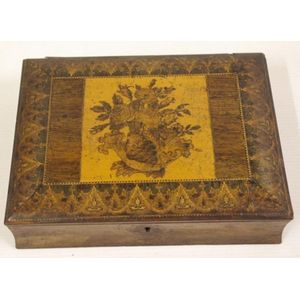
Antique Tunbridge Ware Sewing Box with Fitted Interior
Antique Tunbridge ware sewing box, with fitted interior, 25 cm x 19 cm approx ( af to lid and hinges)

Tunbridge Ware Stationery Box with Castle Scene Decoration
Antique Tunbridge ware stationery box, decoration with a castle scene, flowers and scrolling foliage, 21 cm wide, 13 cm high approx

Victorian Tunbridgeware Box with Floral Mosaic Decoration
A fine Victorian Tunbridgeware box, circa 1860s, the finely worked parquetry box, with a large diamond set within borders to the lid intricately decorated with a tapestry style floral mosaic in natural wood tones and soft colours against a darker ground,…
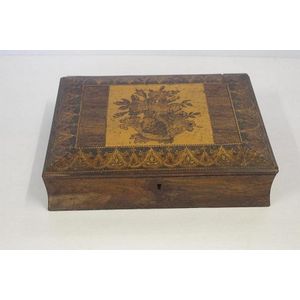
Tunbridge Ware Box with Fitted Interior
Antique tunbridge ware box with fitted interior, 25 cm wide approx

Rare Antique Tunbridge Workbox with Castle Panel Top
Fine and rare antique Tunbridge workbox, by Nye, Late Lemier and Nye Manufacturer 'Tunbridge and Wells' with impressive Tunbridgeware castle panel to top, with Tunbridge cotton spools, crochet discs, letter opener etc, original silk and label to base,…

Victorian Rosewood Sewing Box with Tunbridge Ware Inlay
A Victorian rosewood and Tunbridge ware sewing box. Width 30 cm

Tunbridge Sewing Box with Accessories (A/F)
Mid 19th century Tunbridge ware sewing box with fitted interior and sewing accessories A/F

Victorian Tessellated Tunbridge Ware Floral Box
A Victorian tessellated Tunbridge ware box, late 19th century, resembling petit point, the finely tessellated box having floral and patterned veneer borders to the sides and lid, the centre with a similarly worked floral spray upon a blonde wood panel;…

Victorian Beaded Floral Footstools (Set of 3)
Three Victorian footstools with beaded and floral upholstery, including a walnut and Tunbridge ware example (diam27 cm); a rosewood footstool with raised beaded cushion (width 31 cm) and another circular (diam 39 cm). (3)
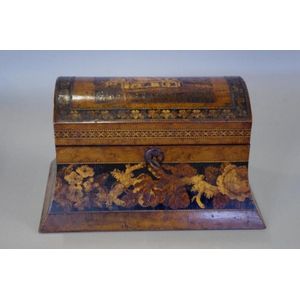
Antique Tunbridge Ware Filing Box with House Scene
Early Tunbridge ware box, decorated with a scene of a house on the lid, ornate borders and a flowering plant band around the base, interior is fitted with filing compartments, 25.5 cm wide, 16.5 cm deep, 15 cm high

Tunbridge Ware Writing Slope - Antique Wooden Desk Accessory
Wooden Tunbridge ware writing slope, approx 16.5 cm high, 30.5 cm wide, 23 cm deep

Tunbridge Sewing Box with Key and Bun Feet
Tunbridge ware sewing box, on 4 bun feet & with key, 26 x 19 x 9.5 cm approx
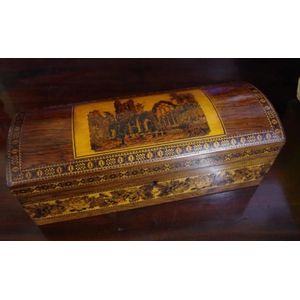
Tunbridge Mosaic Ruins Glove Box
Tunbridge ware glove box, with mosaic scene of ruins to lid, 27 cm wide approx

Tunbridge Ware Sewing Box with T Barton Label
Tunbridge ware sewing box, retains T Barton manufacturers paper label to base, 23 ax 17 x 8.5 cm approx
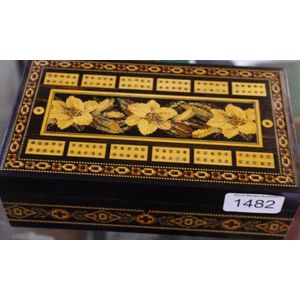
Tunbridge Ware Card Games Box with Cribbage Board
Tunbridge ware card games box, one with mosaic cribbage board to lid & retains T Barton manufacturers paper label to base, 20 x 12 x 6.5 cm approx

Tunbridge Ware Card Games Box with Cribbage Board
Tunbridge ware card games box, with removable cribbage board, 23 x 15 x 8 cm approx

Victorian Walnut and Tunbridge Ware Casket
A Victorian walnut and Tunbridge ware casket. Width 29 cm

Victorian Tunbridge Ware Mother of Pearl Casket
A Victorian walnut and Tunbridge ware casket; mother of pearl inlaid, paper-lined interior. Width 25 cm
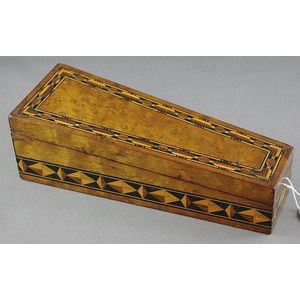
Tunbridge Ware Coffin-Shaped Cotton Reel Box
Antique Tunbridge ware cotton reel box of coffin shape, with Sotheby's Belgravia label to base, 16.5 cm long approx.

Victorian Walnut Tunbridge Ware Box with Mosaic Bands
A Victorian walnut Tunbridge ware box, circa 1880s, with mosaic patterned bands in colours around the box and with a hexagonal cartouche and matching escutcheon, and having black silk lining; with key. Height 10 cm. Length 19.5 cm. Width 12 cm.

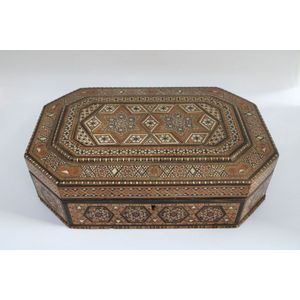
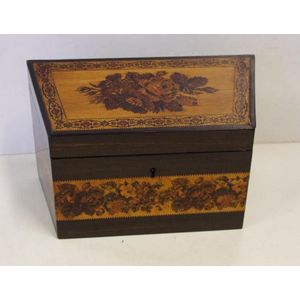





 Loading more...
Loading more...